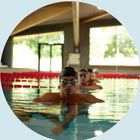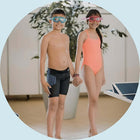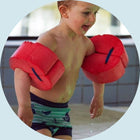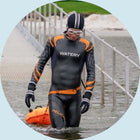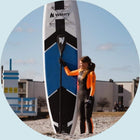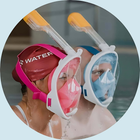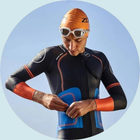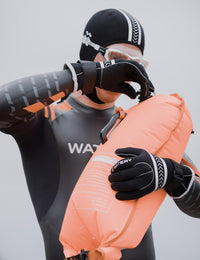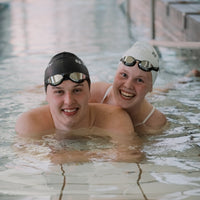Learn to swim backstroke correctly in 7 steps
Backstroke Body Position
The backstroke body position should be parallel to the water's surface: your head's position should dictate what happens. It's important to have a straight line from the top of your head down your back, parallel to the water's surface. Your nose should point up towards the sky/ceiling. Your shoulders should be rolled forward to create a slight arch in your back.
Backstroke Kick
During the backstroke kick, create a lot of bubbles, give it enough power so you feel the water churning at your toes. Remember! Kick with relatively straight legs, kick more from the hips, relax your ankles, and just go for it. If your knees come out of the water, you are bending them too much.
Backstroke Kick and Body Rotation
Once you have control of your kick while lying on your back in the parallel position, start adding some body rotation. While you kick, lift one shoulder out of the water, let the other shoulder drop underwater - remember to keep your body in a parallel line, nose toward the ceiling, keep kicking, and then switch shoulders. Kick with one shoulder up for 3-10 kicks, then switch to the other shoulder. Repeat. Repeat. Repeat. Hopefully, you see a pattern here.Breathing
Hmmm. Your face is above the water at all times. When can you breathe while swimming backstroke? More or less whenever you want! A typical pattern is to breathe when one arm is in the air and exhale when the other arm is up.More Kicking and Body Rotation
Now, change your arm position while you kick. One arm should point in the direction you are going, and the other should be by your side, with your biceps just below your ear. Remember that your nose should point up toward the ceiling! Switch arms by moving your arm next to you in a large rainbow shape through the air.Arms - Pulling in Backstroke
When using your arms, your thumb should be the first to leave the water, and your little finger should enter the water first. This may not always be seen in the Olympics, but it's the easiest way to learn. This should align with the moment one arm enters the water (little finger first), while the other arm is on its way up (thumb first).Swim Backstroke
Congratulations, you are now swimming backstroke! Keep going and remember that if something goes wrong at any of the points, try going back a couple of steps, and you'll get the hang of it.
Below is a short video where you can see how it's done:
What is Backstroke as a Swimming Style?
Simply put, backstroke is a swimming style that sets itself apart from the other three.
It does this mainly by having the swimmer lie on their back, which also allows for free airways for breathing.
However, this also means that the style requires familiarity with swimming while lying on your back and a good sense of direction. This can deter some people, although you usually learn it quickly by looking for the flags overhead.
Ideally, backstroke can look like this:
3 Good Tips for Your Backstroke Swimming
The biggest challenge for most swimmers in backstroke is finding the correct water position - meaning lying flat in the water, rather than having your legs sink to the bottom and your head above water. You must avoid this at all costs when swimming.
GET A DISCOUNT CODE WITH 10% OFF
The discount code can be used by all new customers on all products on the website, including the products recommended here in the article.
What are you waiting for? Get more out of your time in and on the water!
To address this, here are 3 good tips to keep in mind the next time you're in the water. These should help you avoid the problem mentioned above.
Rotate Your Shoulders
Rotation around your longitudinal axis - which follows your arm strokes - is one of the significant details that give you a natural swim. But rotation can also be a bit challenging to master.
In simple terms, you should let the arm stroke movement guide your body. When you've grabbed the water with one arm, turn your body. The advantage of this is that you:
Can grab the water deeper and more efficiently, leading to more propulsion.
Significantly reduce water resistance because you create more resistance when lying flat in the water compared to on your side.
On the other hand, you shouldn't over-rotate, either. You ensure this by never crossing your legs over each other.
Lift Your Chin
You might have a tendency to look down your body when swimming backstroke - meaning your chin gets pressed down toward your chest.
You should avoid this, as it will cause your spine to automatically curve if you do what's mentioned above, creating unnecessary water resistance.
To solve this, lift your chin so that you're looking straight up at the ceiling/sky.

Watery swim cap - Tales Bubble - Black
4.38/5
Based on 8 reviews
Beware of “Bicycle Legs”
A typical mistake for most new swimmers is to immediately start making bicycle legs when swimming backstroke. This is a significant mistake, as it only increases water resistance. This mistake is often seen when the knees come above the water's surface while swimming.
For the backstroke kick, start at the hip, and then the knees and ankles should follow the movement with almost straight knees and ankles. The movement should only be up and down.
